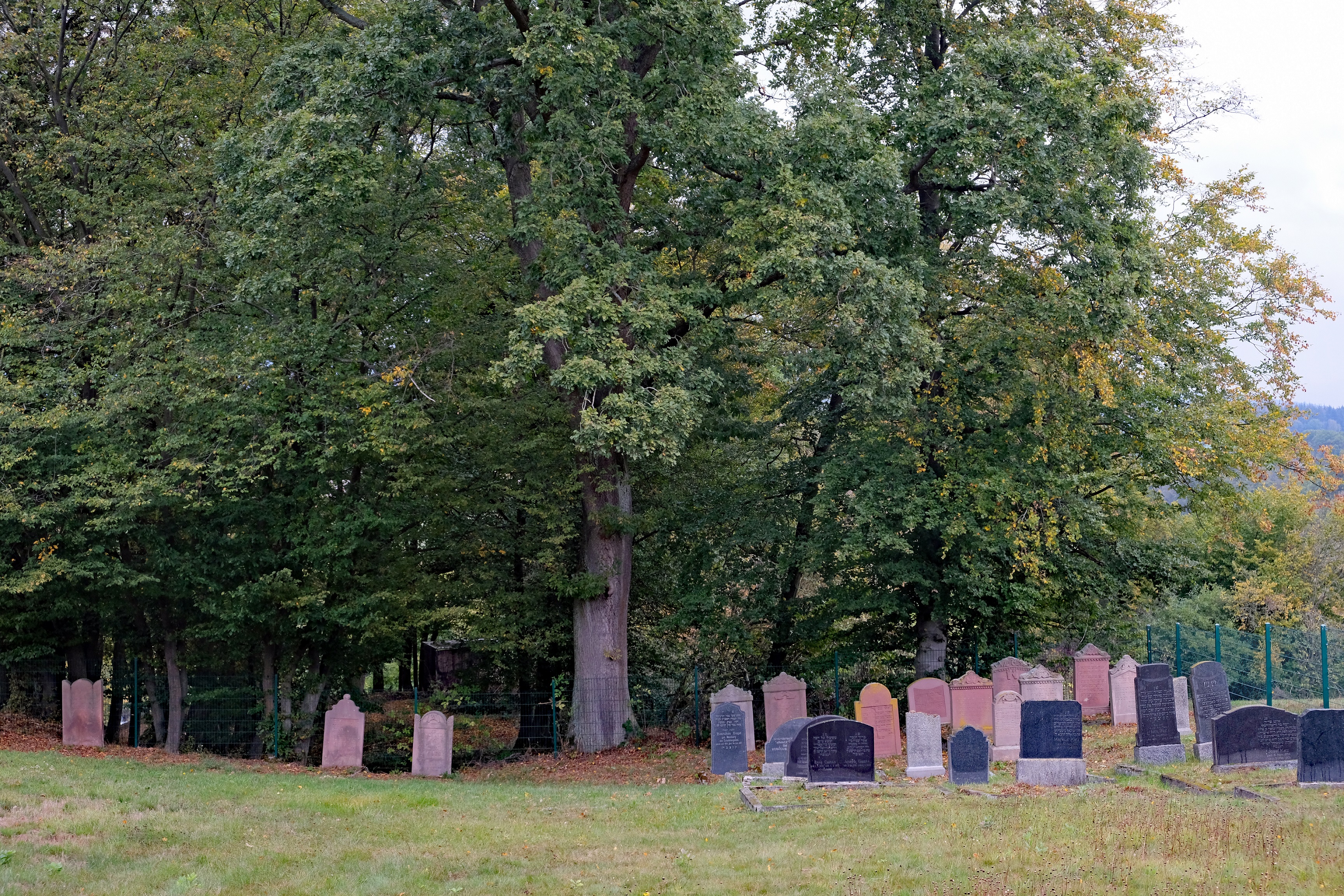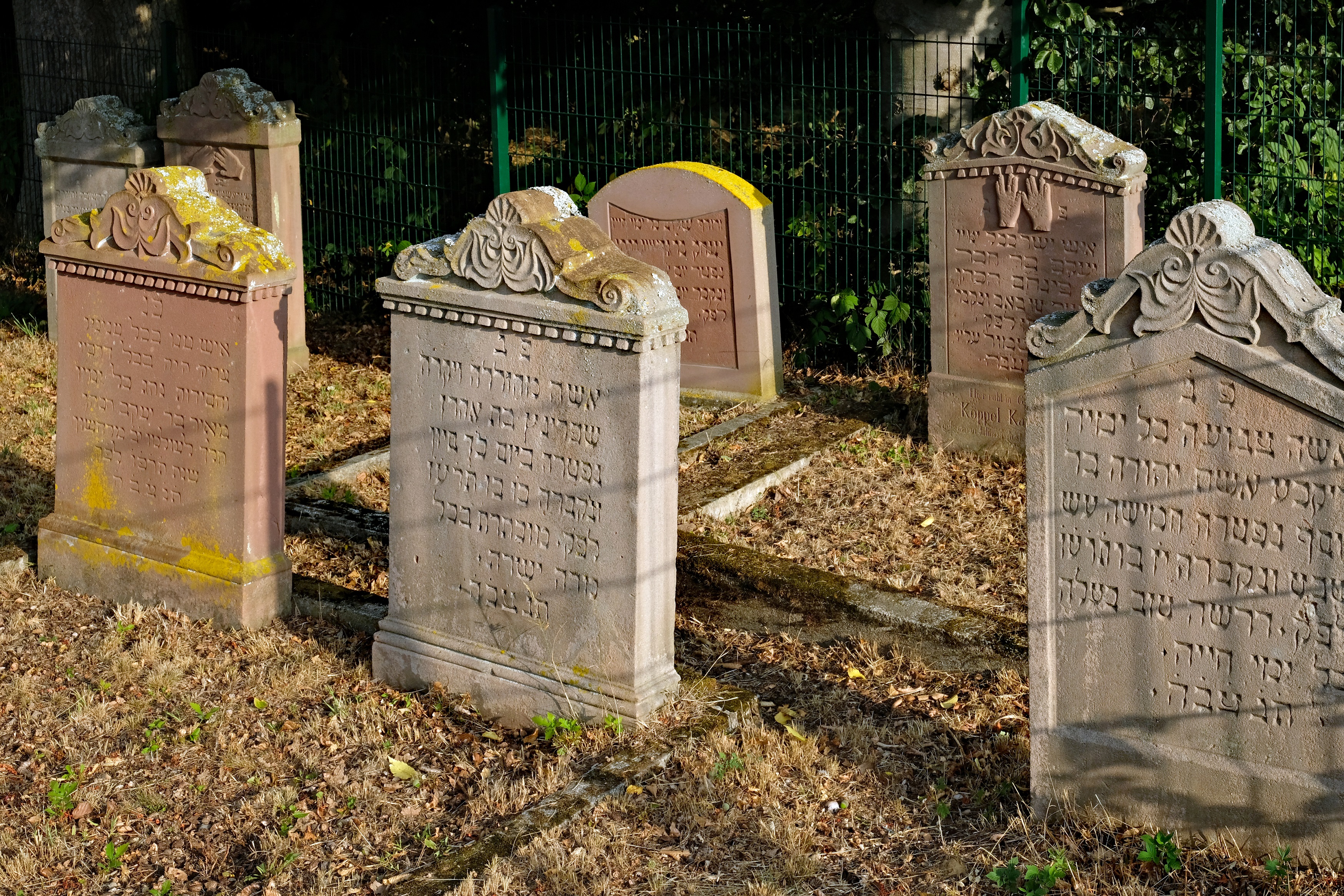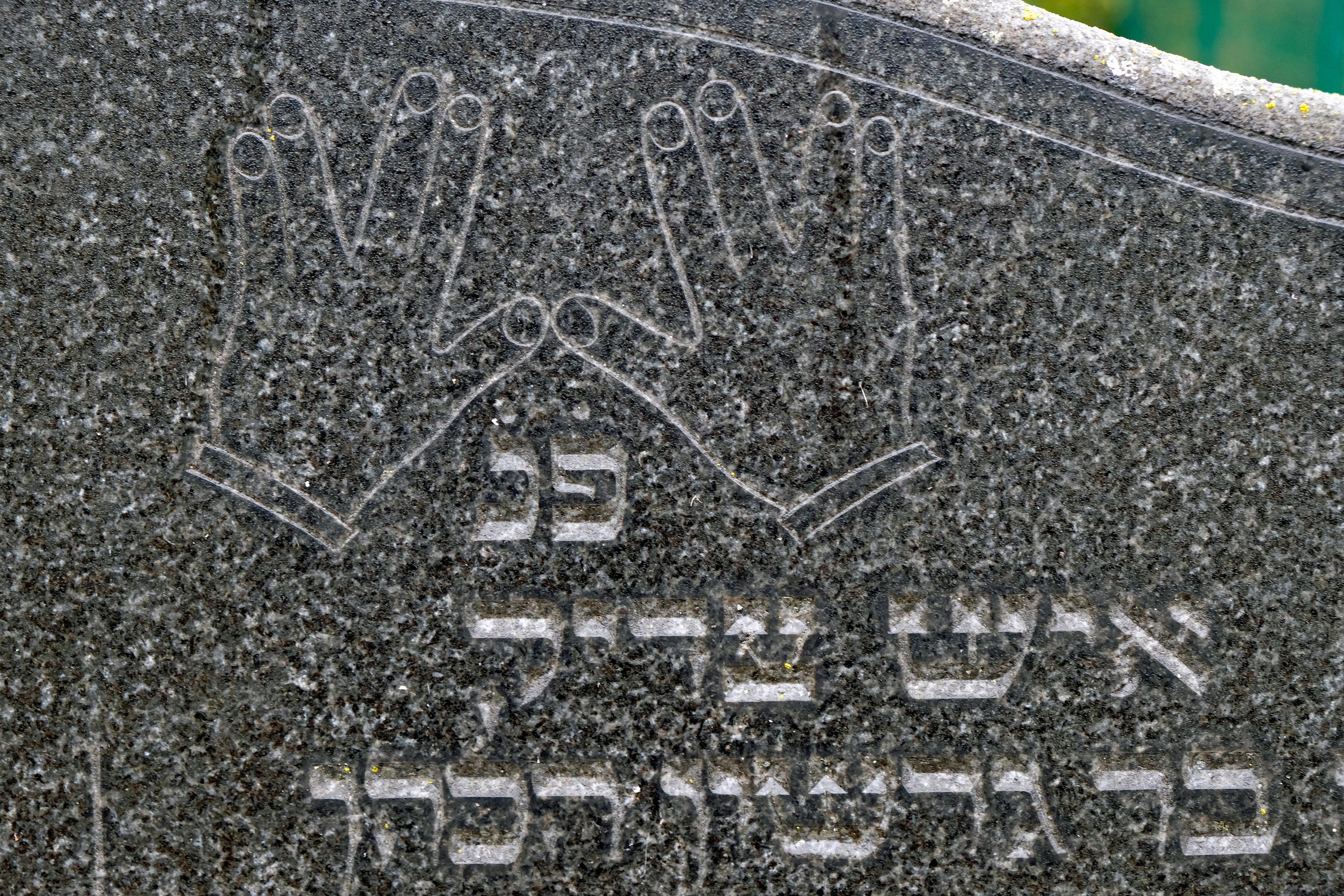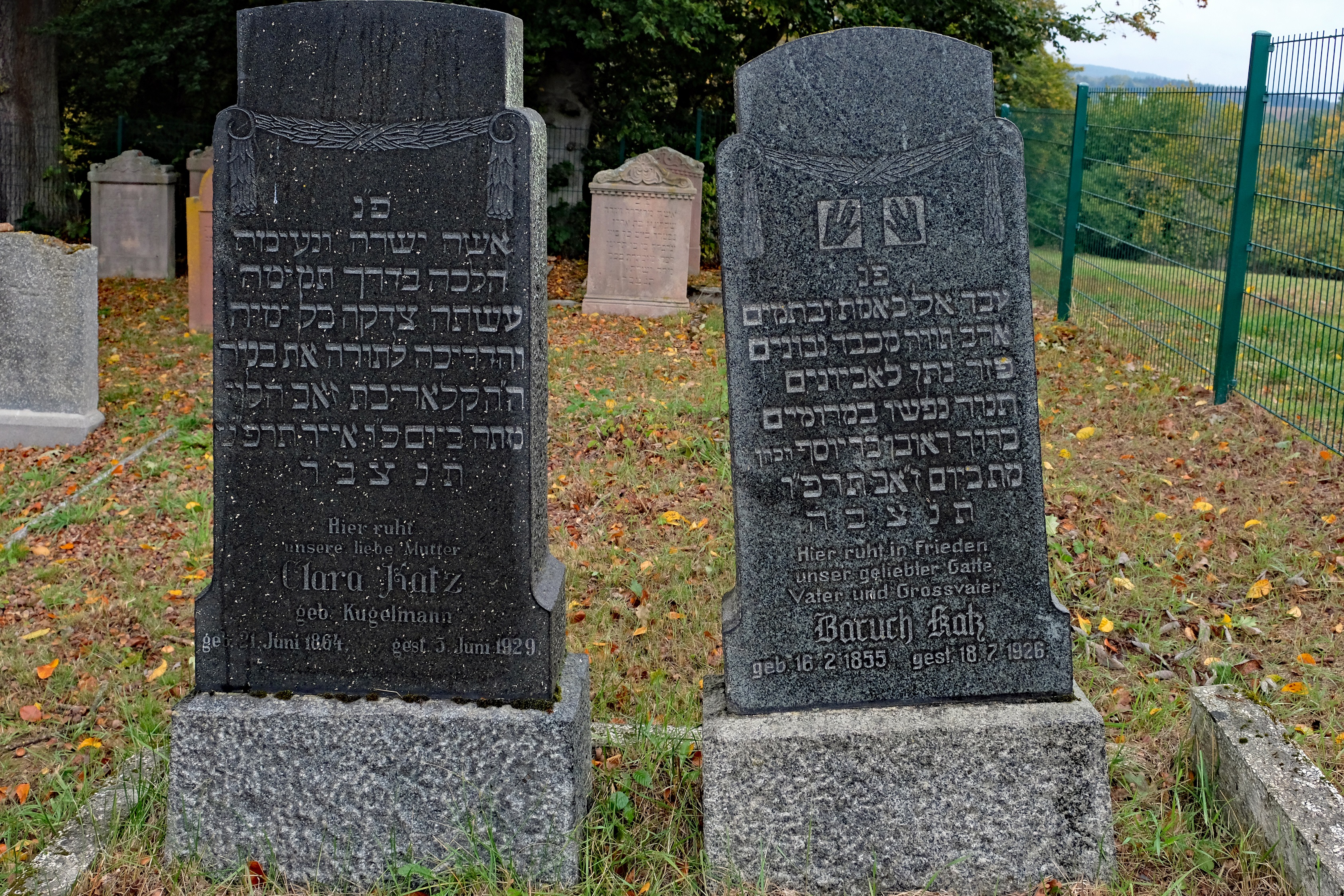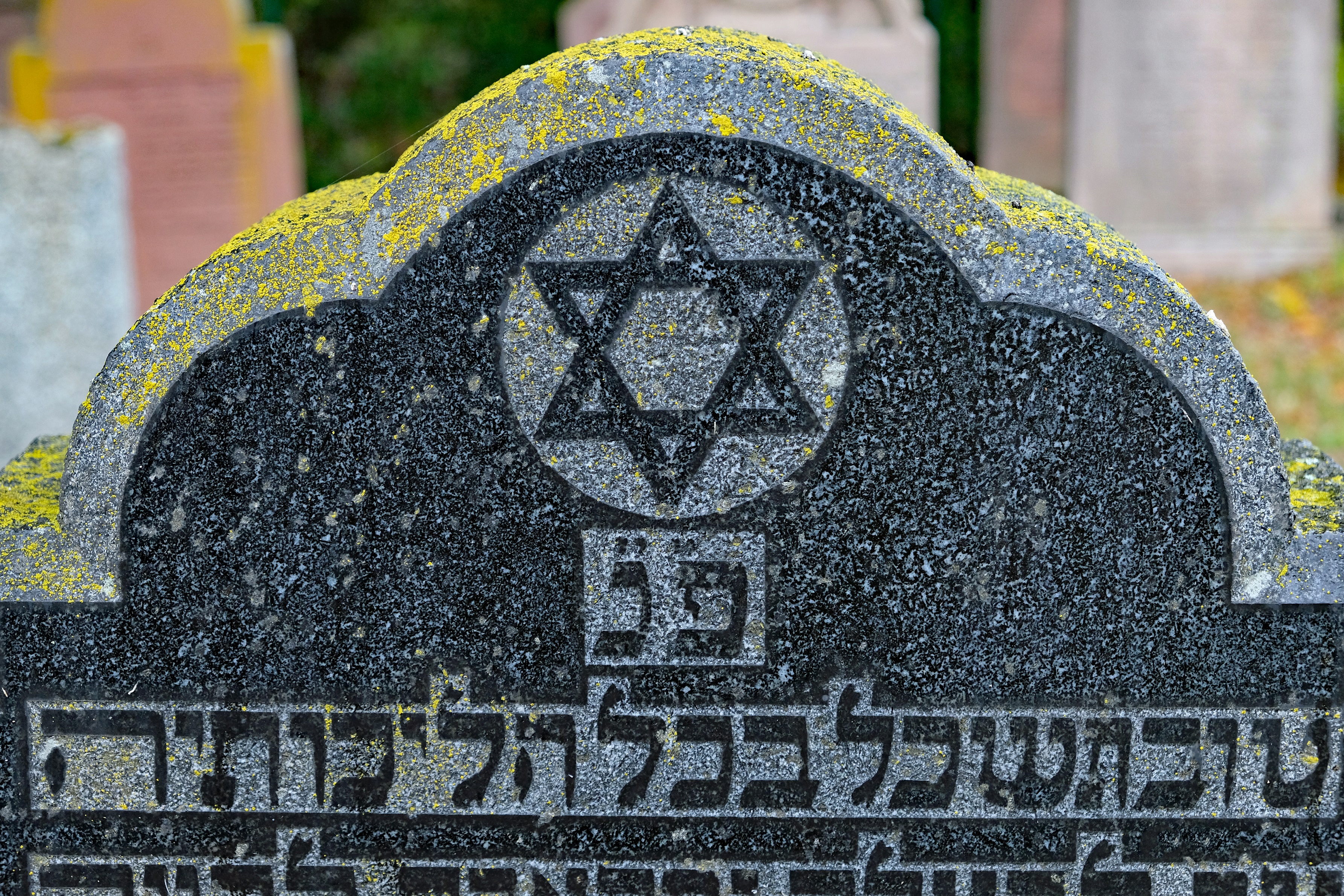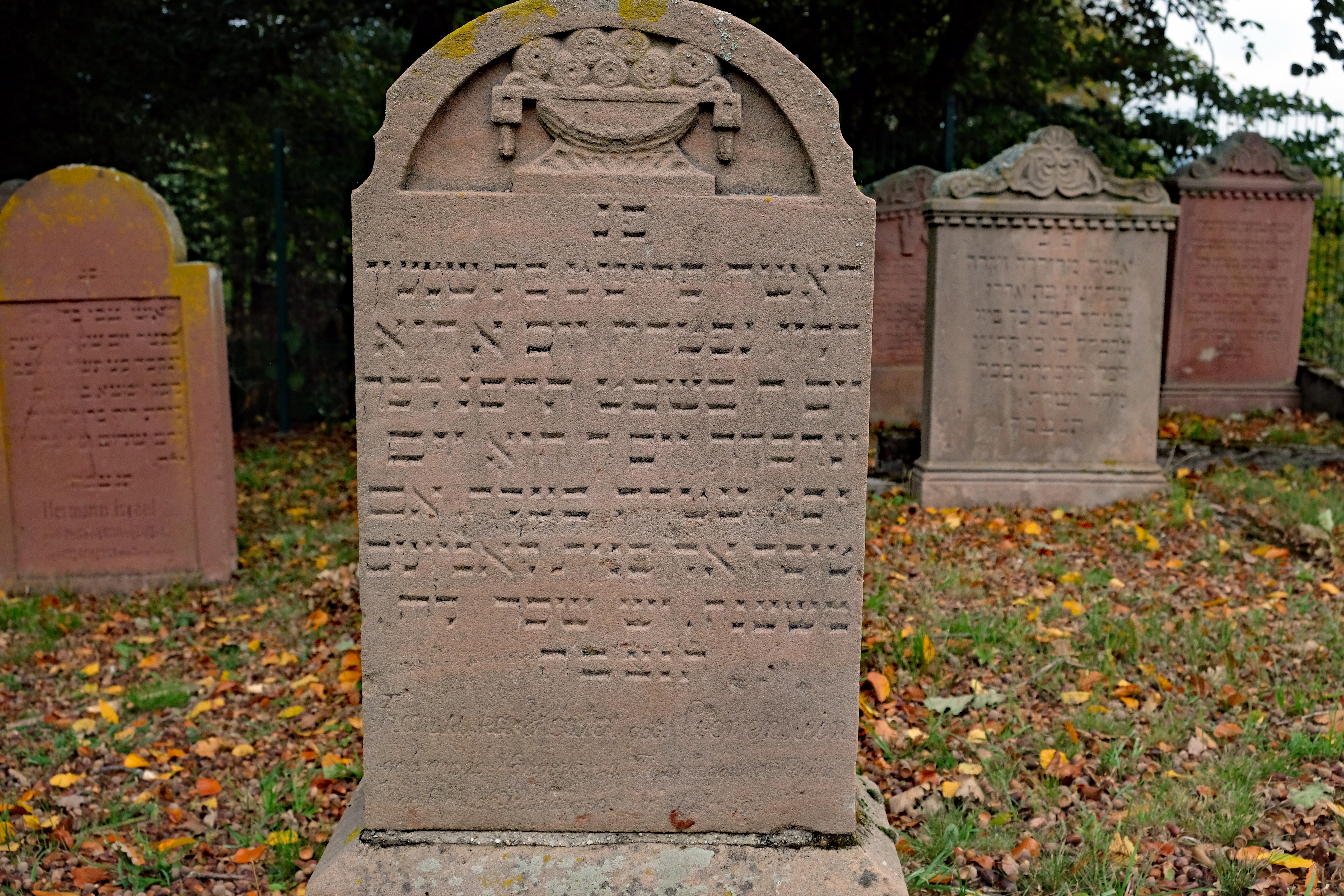Der jüdische Friedhof in Jesberg
In Jesberg sind wahrscheinlich seit der Zeit nach dem 30jährigen Krieg jüdische Familien ansässig. Aber erst nach fast 200 Jahren war die israelitische Gemeinde so angewachsen und gefestigt, dass sie sich entschied, eine eigene Synagoge zu errichten.
Aus dem Jahr 1776 sind 7 Juden in Jesberg belegt. 1835 werden 53 Jesberger, jüdischen Glaubens erwähnt und in diese Zeit fällt der Neubau der Synagoge vor der Gilsabrücke (Eckerbrücke) in der früheren “Hintergasse”, heute Densberger Straße. Die Zahl der Gemeindemitglieder stieg im 19. Jahrhundert noch weiter. 1885 gab es 85 Juden in Jesberg, dies entsprach 10% der Gesamtbevölkerung.
Bei einer solch großen Glaubensgemeinschaft kam es natürlich auch vermehrt zu Bestattungen. Die jüdische Gemeinde Jesberg war bis hier hin Mitglieds-Gemeinde des israelitischen Verbands-Friedhofs in Haarhausen. Hier hatten sich mehr als ein Dutzend Gemeinden aus dem Borkener Umkreis zusammengefunden, um den Friedhof zu unterhalten und zu verwalten.
Der jüdische Friedhof in Haarhausen ist einer der ältesten in Hessen. Er soll bereits seit der Mitte des 16. Jahrhunderts bestehen. Für Juden war es über viele Jahrhunderte schwer, überhaupt eigene Begräbnisplätze zu erwerben. Meist wurde ihnen nur dasjenige Land überlassen, das nicht anders genutzt werden konnte. Ein Rittergutbesitzer hatte wohl der damals recht großen israelitischen Gemeinde eine 78,32 a (7832 m²) große Fläche zur Verfügung gestellt, um dort einen Friedhof zu gründen. 372 Grabsteine sind auf dem Haarhäuser Friedhof zu sehen, der älteste aus dem Jahr 1705, der jüngste aus dem Jahr 1940.
Eine Beerdigung der Jesberger Juden war also mit einem 12km langen und beschwerlichen Weg verbunden, der bei Wind und Wetter zurückgelegt werden musste. Um 1900 war der Haarhäuser Friedhof nahezu völlig belegt und die überwiegende Zahl der beteiligten Gemeinden hatten bereits eigene Friedhöfe angelegt. Die Pflege und Instandhaltung gestalteten sich nun schwierig. Da die Jesberger Juden um die Jahrhundertwende nun auch in wirtschaftlich sicheren Verhältnissen lebten, wurde nun auch hier ein eigener Friedhof angelegt.
Auf einem eigenen, 10,92 a großen Gelände am Rande des Hembergs wurden nun die Gemeindemitglieder bestattet. Der Friedhof liegt jenseits der Siedlung, weil Tote nach jüdischem Reinheitsgebot als kultisch unrein gelten. So soll ein jüdischer Friedhof wenigstens 50 Ellen (57,15 m) vom äußersten Haus einer Stadt oder eines Dorfes entfernt sein. Das erklärt die Lage des Friedhofs am Hemberg, jenseits des Dorfes.
Aus einem Artikel aus dem Jahr 1903 geht hervor, dass er 1903 bereits eingeweiht war. Die erste Bestattung fand Ende Dezember 1902 statt, die letzte im August 1933. Insgesamt fanden ca. 30 Jesberger und Densberger (gehörten ab 1905 zur Jesberger Gemeinde) Juden hier ihre letzte Ruhe. Wie aus den Akten hervorgeht, befinden sich noch 26 Grabstätten/Grabsteine auf dem Friedhof. Sie waren Mitglieder folgender Familien:
- Schloss
- Ganss
- Katz
- Katzenstein
- Stern
- Höxter
- Vogel
- Israel
- Köppel
Im Judentum sind nur Erdbestattungen vorgesehen. Die Grabstellen sind dauerhafte Ruhestätten, ohne zeitliche Befristung. Den Toten darf der Ruheort nicht genommen werden, da sie auf die Auferweckung „am Ende der Tage“ und auf ein ewiges Leben von Leib und Seele warten. Der jüdische Friedhof ist somit unantastbar. Deshalb heißt der Friedhof im Hebräischen auch „Haus der Ewigkeit“, „guter Ort“ oder „Haus der Gräber“.
Am Sabbat fanden weder Bestattungen statt noch wurde der Friedhof besucht. Männer (auch Nichtjuden) müssen beim Besuch eine Kopfbedeckung tragen. Statt Blumen als Grabschmuck wurden in der Regel kleine Steine auf das Grab gelegt. Die Sitte des Steinablegens erinnert an die Zeit der Wüstenwanderung des Volkes Israel. Steine verhinderten, dass die Leichen von wilden Tieren ausgegraben wurden. Wurde eine Bestattung vorgenommen, brachten Freunde oder Stammesverwandte einen Stein mit, um das Grab zu bedecken.
Bis zum 18. Jahrhundert wurden die Toten nach Jerusalem ausgerichtet, dies änderte sich dann ebenso wie die Grabsteingestaltung. Ursprüngliche wurde die Beschriftung in Hebräisch angebracht. Die Haskala (die jüdische Aufklärung) führte hier zum Angleichen an die christliche Gestaltung der Grabsteine. Sie wurden dadurch aufwendiger gestaltet. Die Beschriftung war dann auf der Vorderseite in Hebräisch, auf der Rückseite in der Landessprache. Verschiedene Motive zierten die aufrechtstehenden Steine.
Traditionelle Grabsteinmotive:
- Rosen und Blumen
- Levitenkanne
- Segnende Priesterhände
- Channukkaleuchter
- Löwe
- Segnende Hände
- Gebrochener Baumstamm
- Davidstern
- Zedaka-Box
- Vogelpaar
Die segnenden Hände verweisen auf die Herkunft des Toten aus dem Priestergeschlecht Aarons. Sie deuten die Segensgeste des Priesters an. Familiennamen wie Cohen, Katz und Kahn erinnern ebenfalls auf eine Herkunft aus einer alten Priesterfamilie.
Das Symbol einer Kanne (Levitenkanne oft mit Wasserschale) verweist auf die Herkunft des Toten aus der altpriesterlichen Familie Levi (Tempeldiener). Familiennamen, die an diese Herkunft erinnern sind Levi, Lewin, Löwe, Löwenthal u.ä..
Rosen und Blumen finden sich auf den Grabsteinen als schmückendes Element. Gerne wurde sie bei Frauen mit Namen Röschen verwendet. Oft schmückt die gebrochene Rose auch das Grab eines früh verstorbenen Mädchens.
Der Davidstern ist häufig auf Grabsteinen anzutreffen. Das Hexagramm ist ein altes Zeichen, das sich immer mehr zum Sinnbild des Judentums entwickelte. Seine sechs Ecken stehen zeichenhaft für die sechs Tage, das Sechseck in der Mitte für den 7. Tag, den Sabbat, an dem Gott von seinem Werk ruhte.
Anmerkung: Der Schlüssel zum Friedhof ist bei der Gemeindeverwaltung Jesberg erhältlich.
(Verfasserin: Sandra Kurzrock (Ortsvorsteherin Jesberg) mit freundlicher Unterstützung von Pfarrer Reinhard Keller, Jesberg)
Glossar
Name | Umrechnung | Fläche | Abk. | Name | Umrechnung | Fläche | Abk. |
Ar | 10 m x 10 m | 100 m² | a | Hektar | 100 m x 100 m | 10000 m² | ha |


